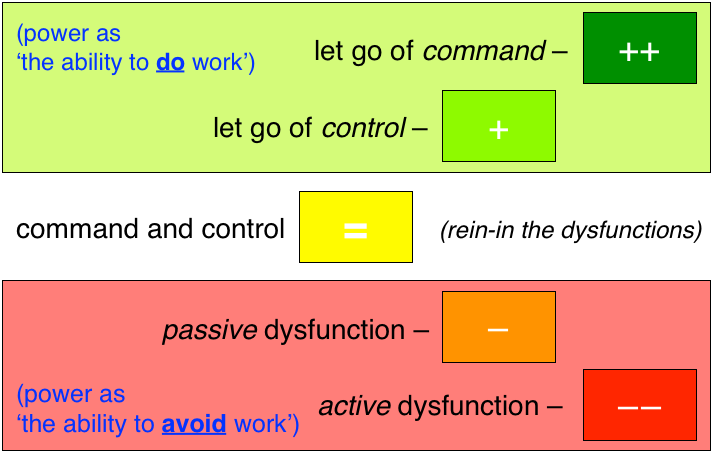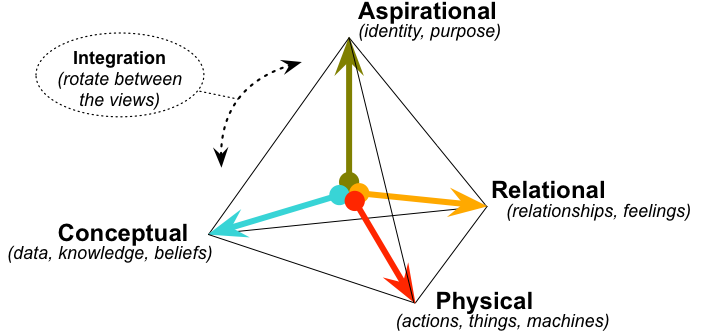On cults
What is a cult? What is it that underpins a cult? From where do cults gain their power? And how do the same principles apply within organisations?
Over on Twitter, Mel Conway (of ‘Conway’s Law‘) asked this question:
We all need an explanation, with minimum psychobabble, how and why cults are so powerful. It seems to me that a cult could be described as an emergent phenomenon that derives from some kind of coupling between the needs of the leader and the followers.
Any help out there?
I based my reply on the SEMPER power-model:
…and the types of work implied by the ‘asset-dimensions‘ used in my work on enterprise-architectures:
The following is my Twitter-thread reply – numbered paragraphs are the individual tweets, paragraphs in ‘(..)’ parentheses are additional notes:
1. A cult is a mutual responsibility-avoiding device, operating as a form of pyramid-game (Ponzi scheme). It requires the existence of a blameable ‘the Other’ (scapegoat).
2. The core of a cult is a belief about power. In physics, power can be described as ‘the ability to do work’. In a cult (and many other social contexts), power is defined more as ‘the ability to avoid work’. (This is often framed as a ‘right’ to avoid some form of work.)
3. In physics, ‘work’ is ‘the rate at which energy is expended’. In a human context, ‘work’ is anything on which humans expend energy. Hence here, ‘work’ may be physical, mental, emotional/relational, spiritual (e.g. meaning and purpose), and/or other forms.
4. In a cult, some crucial form of work is being avoided. Instead, the work is offloaded onto an Other, who is then blamed/denigrated for doing that work. A slave-culture is a cult that entraps a denigrated Other (slaves) to do undesired work (usually physical-work).
5. (Most so-called ‘advanced’ cultures are actually still slave-cults: the only difference is that we rely on machines rather than other people to do the undesired ‘slave-work’.)
6. The cult is thus dependent on the existence of the Other to do the work that is being avoided – but must also maintain separation from the Other, in case the [avoided] work returns (‘return of the scapegoat’).
7. Maintaining that separation requires work – in fact becomes a major part work of the cult. The driver for that work is the fear that the offloaded-work will somehow return (as it in fact must, if the work is of a type that can only be done by the Self, e.g. relational).
8. In a cult, the role of the Leader is that it gives permission to blame the Other (i.e. to be ‘right’ to offload that work onto the Other). For the cult to ‘succeed’ in this, the Leader must be infallible, perfect – a ‘god’, or seen as ‘godlike’ (e.g. a narcissist).
(Note: For a cult, the existence of a Leader is useful but not always essential: a cult can still work as such, as long as there is some mutual means – such as clubs or internet-chat-rooms – to agree that the ‘right’ does exist to blame and offload responsibility for work onto the Other. A Leader is merely a useful figurehead to whom the responsibility for that item of work – providing the ‘permission to abuse the Other’ – is offloaded. A figurehead who fails in that role risks facing much of the abuse that would otherwise be heaped on the Other – hence, in a very real sense, only imaginary gods or rabid narcissists can safely apply for that Leader role.)
9. Since essential work is being avoided, the cult is inherently fragile – literally built on mutual [reinforcement of] self-delusion. The longer the work is avoided, the more that tension will increase – and likewise the fear of ‘the return of the scapegoat’.
10. A cult will break down – implode, often with a level of violence that reflects the scale of work that has been previously avoided – whenever at least one of several crucial conditions are met. These include:
11. Condition A: The illusion of the Leader’s supposed perfection or infallibility breaks down (and hence the perceived ‘permission to blame’, the ‘right’ to offload the work onto the Other).
(Note: The need to prevent Condition A from occurring will often create a drive within the cult to ignore or reject any information that might raise any doubt about the perfection of the Leader. This is the trade-off that makes the role of cult-Leader so desirable for a narcissist: in return for providing and maintaining that ‘permission to abuse the Other’, the reward is an unending source of unquestioned praise.)
12. Condition B: The cult becomes universal, encompasses everyone/everything (i.e. there is no-one left to blame and treat as Other, hence there is no-one/no-thing onto whom the work can be offloaded).
13. Condition C: The Other refuses to [continue to] accept responsibility [and/or blame] for the work that is being offloaded (e.g. ‘slaves’ revolt’).
14. Condition D: The Other becomes unable to accept responsibility for the work that is being offloaded (e.g. slaves starve or die out, machines run out of energy).
15. Condition E: Changes in the external-reality force a breakdown of the illusion that the work can be avoided forever (e.g. crop-failure, epidemic, resource-depletion, or inability to block out external sources of information).
(Note: The need to prevent Condition E from occurring is both a source for the creation and maintenance of information-bubbles, and a major driver behind why such bubbles can be so fiercely maintained and defended, and so hard to break.)
16. For the cult, each of those conditions is literally an existential threat, and hence must be resisted / fought-against at all costs.
17. Those who wish (or need) to bring the cult to an end will need to bring about at least one of those conditions – though need also to be wary of the spiralling violence that the cult must bring to bear against any such perceived threat.
18. Cults can occur in many different forms, at many different scales (e.g. organisations may often show strong cult-type characteristics).
19. For organisations, external consultants may play both the role of Leader (giving ‘permission’ to offload work onto the Other), and also the role of Other (onto whom the responsibility/blame for e.g. decision-work is offloaded).
20. To identify the potential presence of a cult, look for: a) some form of work being avoided; b) some blameable Other onto whom the work can be offloaded; c) some purported-infallible Leader who gives permission to blame/punish the Other.
I hope that’s useful, anyway – over to you for comments and suchlike if you wish!


Thank you Tom Graves, simple, clear and accurate. Good work!